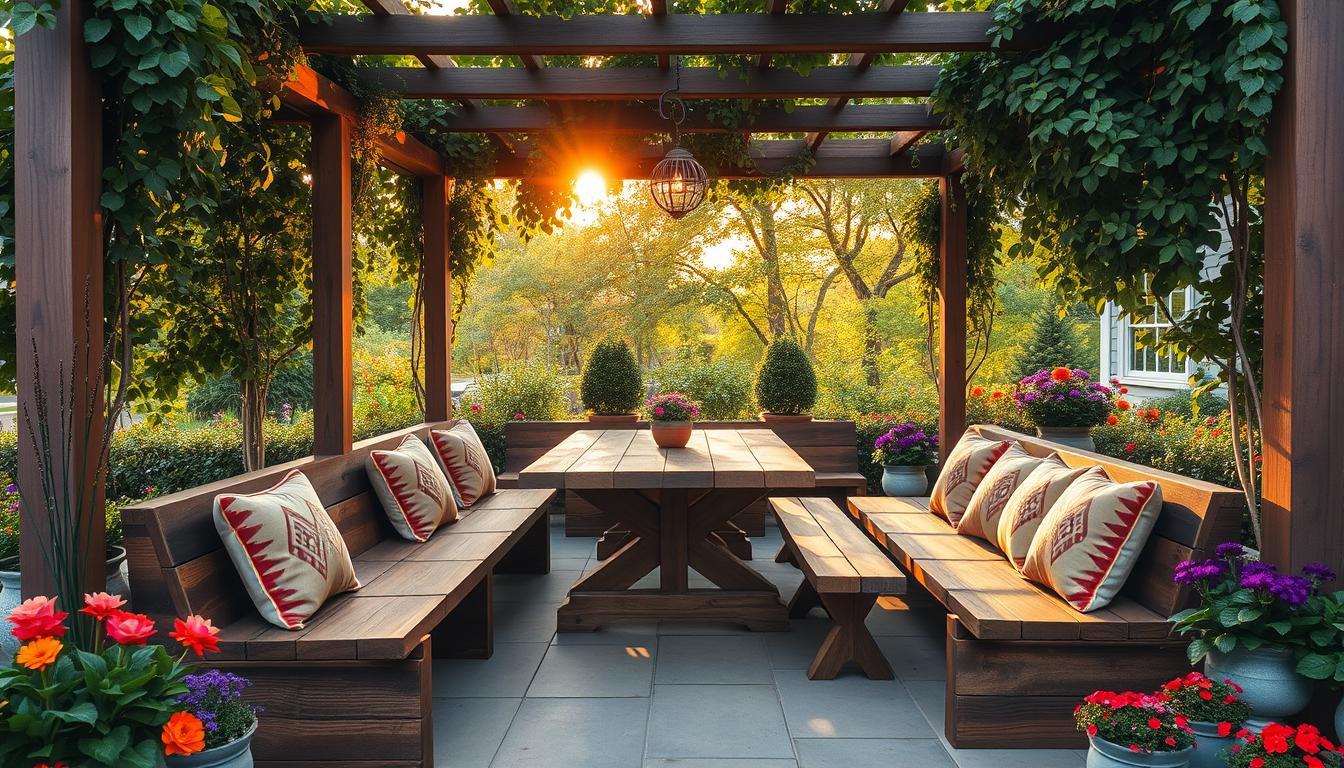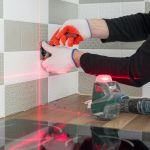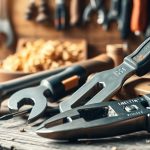Creating custom outdoor furniture is a rewarding DIY project. It allows you to design a beautiful, functional outdoor space that mirrors your personal style. This includes incorporating elements of outdoor furniture and seating design.
With the right materials and planning, you can craft a cozy reading nook or a large seating area for entertaining. This maximizes your outdoor space with custom seating design and outdoor furniture.
Whether you’re an experienced DIYer or a beginner, building custom outdoor seating can elevate your outdoor living experience. It focuses on outdoor furniture and seating design.
Introduction to Custom Outdoor Seating
In this article, we’ll dive into the process of building custom outdoor seating. We’ll cover planning and design, construction, and finishing. Topics such as outdoor furniture and seating design will be discussed.
Key Takeaways
- Custom outdoor seating can be a fun and rewarding DIY project
- Outdoor furniture and seating design play a crucial role in creating a functional outdoor space
- Planning and design are essential steps in building custom outdoor seating
- Choosing the right materials is critical for durability and longevity
- Custom outdoor seating can enhance your outdoor living experience
Planning Your Custom Outdoor Seating Project
Creating a custom outdoor seating area requires careful planning. You need to assess your space, understand local building codes, and set a project timeline. Proper planning ensures your outdoor seating is safe, functional, and meets your needs.
A well-thought-out bench building project can transform your outdoor space. Consider the size and shape of your area, along with the seating type you desire. It’s also crucial to research local building codes to ensure compliance with laws and regulations.
Assessing Your Space Requirements
Start by measuring your outdoor space and think about the patio furniture you want. List the features you need, such as seating, tables, and planters. This will help you design a layout that’s both functional and comfortable.
Understanding Local Building Codes
It’s essential to understand local building codes for your project. Research the specific codes in your area and include them in your plan. This step helps avoid legal issues and fines.
By following these steps, you can design a custom outdoor seating area that’s both beautiful and functional. It will enhance your outdoor space and meet your needs.
Essential Materials for Outdoor Seating Construction
Choosing the right materials for outdoor seating is critical. You need materials that are durable, weather-resistant, and easy to maintain. For weather-resistant seating, cedar, teak, or recycled plastic are excellent choices. These materials ensure your garden benches can endure the elements.
When selecting materials, don’t overlook the importance of hardware and fasteners. They are crucial for ensuring your outdoor seating is not just beautiful but also functional and safe. Stainless steel and galvanized steel are top picks for hardware. They resist corrosion and can handle harsh weather.
Adding cushions or pillows to your outdoor seating can also enhance comfort and style. This is a great way to make your garden benches more inviting. Here are some key benefits of using weather-resistant seating materials:
- Durability: These materials can withstand harsh weather, ensuring your seating lasts long.
- Low maintenance: They are easy to clean and maintain, saving you time and effort.
- Aesthetics: Weather-resistant materials offer a wide range of styles and designs, making your outdoor seating area both beautiful and functional.
By selecting the right materials and considering the features you desire, you can create a stunning and practical outdoor seating area. This will provide years of enjoyment.
| Material | Benefits | Drawbacks |
|---|---|---|
| Cedar | Weather-resistant, durable, and aesthetically pleasing | Can be expensive, may require periodic sealing |
| Teak | Weather-resistant, durable, and low maintenance | Can be expensive, may require periodic oiling |
| Recycled plastic | Weather-resistant, durable, and eco-friendly | May not be as aesthetically pleasing as other materials, can be expensive |
Selecting Weather-Resistant Woods and Materials
Choosing the right materials for outdoor furniture is key to creating both beauty and functionality. The correct materials ensure your seating areas endure the elements, staying comfortable and safe for years. This is crucial for outdoor spaces.
To pick the best materials for your custom outdoor seating, focus on durability and weather-resistance. Popular choices include:
- Cedar and teak, known for their natural resistance to rot and insects
- Composite materials, like recycled plastic and polywood, which are eco-friendly and low-maintenance
- Metal components and hardware, such as stainless steel and aluminum, for a modern touch
Opting for the right materials allows you to craft a stunning, functional outdoor area. It will withstand the elements, offering a cozy spot for you and your guests. Think about the style you desire and the upkeep you’re ready for when choosing your outdoor furniture and seating areas.
Required Tools and Equipment
For bench building and crafting custom patio furniture, the right tools are key. A well-equipped toolbox significantly impacts project efficiency and quality. You’ll need power tools like a circular saw, drill, and impact driver. Hand tools, including a hammer, tape measure, and level, are also essential.
Don’t forget about safety gear, such as gloves and safety glasses, to safeguard against hazards. A strong workbench and a reliable sawhorse are also vital for a solid base. Here’s a comprehensive list of tools you’ll need:
- Circular saw
- Drill
- Impact driver
- Hammer
- Tape measure
- Level
- Gloves
- Safety glasses
With these tools and equipment, you’re set to create stunning and practical patio furniture and bench building projects. These will undoubtedly improve your outdoor living area.
Always adhere to safety guidelines and best practices when using power tools and equipment. This ensures a successful and enjoyable project.
Basic Design Principles for Outdoor Seating
Designing custom outdoor seating involves several key principles to ensure both functionality and aesthetics. The aim is to create a space that enhances the landscape while offering comfort and durability. This requires careful consideration of various aspects of outdoor furniture and seating design.
A well-designed outdoor seating area must prioritize ergonomic considerations. This includes the height and depth of the seating to ensure comfort and functionality. Style and aesthetics, such as color and texture, are crucial in adding a personal touch. They make the outdoor space an extension of the home’s interior design.
Ergonomic Considerations
Understanding the importance of ergonomic design in outdoor seating is vital. It involves considering the height of seats, their depth, and the presence of armrests. A well-designed area should allow for comfortable sitting for extended periods without discomfort.
Style and Aesthetics
The style and aesthetics of outdoor furniture significantly impact the space’s look and feel. Whether modern and sleek or traditional and rustic, the design should reflect the homeowner’s taste. It should also complement the surrounding architecture and landscape. The choice of materials, colors, and textures adds depth and visual interest.
Structural Support Guidelines
Structural support guidelines are crucial for ensuring the safety and durability of outdoor seating. This includes the type of frame, foundation, and any additional support structures. A sturdy and well-constructed area can withstand various weather conditions and last for years, enhancing the outdoor space.
By adhering to these basic design principles, individuals can create a beautiful and functional outdoor seating area. It meets their needs and complements their outdoor furniture and seating design. This enhances their overall outdoor living experience.
Step-by-Step Bench Building Techniques
Building a custom outdoor bench is a rewarding DIY project. With the right materials and planning, you can craft a weather-resistant seating area that stands the test of time. For durability, opt for weather-resistant woods or composite materials.
A well-crafted garden bench enhances any outdoor space. Begin by designing and planning your bench’s layout. Think about its size, shape, and the type of seating you desire. Adding features like armrests or a backrest can boost comfort and functionality.
- Choose weather-resistant materials for longevity.
- Apply a protective coating to extend your bench’s life.
- Ensure your bench is both comfortable and functional, with ample seating and support.
By adhering to these guidelines and selecting the right materials, you can create a stunning and practical custom outdoor bench. It will be a perfect addition to your garden benches and outdoor seating area.
Creating Custom Garden Seating Areas
Designing your outdoor space requires careful consideration of seating areas. Custom garden seating areas can enhance both functionality and beauty. Incorporating outdoor furniture, like benches and chairs, fosters a cozy, inviting atmosphere.
Incorporating built-in seating, such as benches or wall-mounted seats, is a space-saving strategy. It also promotes a sense of continuity in your garden. Adding integrated planter designs, like planter boxes or trellises, brings greenery to your seating area.
Multi-functional Seating Solutions
Multi-functional seating solutions, such as storage benches or seating areas with built-in tables, add functionality. These spaces serve as places to sit, store items, and entertain guests. By blending outdoor furniture and seating areas, you create a space that is both beautiful and functional.
Popular outdoor seating area options include:
- Benches with storage
- Wall-mounted seats
- Seating areas with built-in tables
- Integrated planter designs
By tailoring your seating area to your needs, you can craft a custom garden space that’s both functional and aesthetically pleasing. Whether you aim for a cozy reading nook or a space for entertaining, a custom garden seating area can significantly enhance your outdoor space.
| Seating Area Type | Description |
|---|---|
| Benches with storage | A bench with a storage compartment underneath the seat |
| Wall-mounted seats | A seat mounted to a wall, often with a backrest and armrests |
| Seating areas with built-in tables | A seating area with a built-in table, often with storage compartments |
Weatherproofing and Finishing Your Outdoor Seating
To ensure your custom outdoor seating, including bench building and patio furniture, lasts for years, proper weatherproofing and finishing are key. This involves several steps to safeguard your investment against the elements and preserve its aesthetic appeal.
Start by examining the materials used in your outdoor seating. If wood was chosen, apply a sealant to shield it from moisture and UV damage. For metal parts, a rust-resistant coating is necessary to prevent corrosion. Opt for durable, weather-resistant materials for patio furniture, such as recycled plastic or wrought iron.
Regular maintenance is also vital to extend your outdoor seating’s lifespan. Develop an annual maintenance routine. This should include inspecting for damage, thorough cleaning, and reapplying sealants or coatings as required. Adhering to these practices will ensure your custom outdoor seating, including your bench building project, remains in excellent condition for years.
Sealant Applications
- Choose a sealant that’s suitable for your outdoor seating material
- Apply the sealant according to the manufacturer’s instructions
- Reapply the sealant as needed to maintain protection
Protective Coatings
Apply a protective coating to metal components to prevent corrosion and extend their lifespan. This is crucial for patio furniture that faces the elements.
Advanced Design Features and Add-ons
Creating unique and functional outdoor spaces requires advanced design features and add-ons. For example, adding lighting to your outdoor furniture extends its use into the evening. This creates a warm, inviting ambiance. You can use string lights, lanterns, or built-in lighting in your seating design.
Heating and cooling systems can also enhance your outdoor seating area. Features like fire pits, outdoor heaters, or misting systems ensure comfort in any weather. These additions make your outdoor space beautiful, functional, and comfortable. It’s perfect for relaxing and entertaining with outdoor furniture and thoughtful seating design.
Consider built-in planters, storage compartments, and outdoor kitchens for your space. These features blend indoor and outdoor living seamlessly. They make your outdoor area feel like an extension of your home. By adding these elements to your seating design, you create a unique, functional space that reflects your style. Enjoying your outdoor furniture becomes even more enjoyable.
Troubleshooting Common Construction Issues
Building custom outdoor seating, like weather-resistant seating and garden benches, often faces common construction issues. These can include uneven ground and material defects. If not resolved, they can affect the safety and durability of your outdoor furniture.
To ensure your outdoor seating is safe and functional, it’s crucial to tackle these common problems. Here are some tips for dealing with uneven ground, fixing instability, and addressing material defects:
- Before building, check the ground’s levelness and adjust as needed for a stable base.
- Choose weather-resistant materials and hardware, like stainless steel, to reduce material defects.
- Regularly inspect your seating for wear and tear, fixing issues promptly to avoid bigger problems.
By applying these tips, you can make sure your weather-resistant seating and garden benches are safe and durable. They will provide years of enjoyment for you and your family.
Dealing with Uneven Ground
Uneven ground poses a significant challenge for custom outdoor seating. To solve this, use shims or adjustable feet to level your seating. Or, build a platform or deck for a stable base.
Fixing Wobbles and Instability
Wobbles and instability can stem from uneven ground, loose hardware, or poor construction. To address these, tighten loose hardware, add support or bracing, or rebuild with sturdier materials.
Conclusion: Enjoying Your Custom Outdoor Seating Space
Now that your custom outdoor furniture is ready, it’s time to unwind and appreciate your new seating areas. Whether it’s a cozy bench, a chic garden bench, or a versatile seating option, your efforts have been worth it. Take pride in your handcrafted piece and enhance the space with outdoor cushions, planters, or lights that match your design.
Host gatherings and use the space for dining, entertaining, or just to soak in the fresh air. To keep your investment in top shape, follow the weatherproofing and maintenance advice shared earlier. With the right care, your outdoor furniture will remain a source of comfort and beauty for many years.
Enjoy the fulfillment of creating a functional and attractive outdoor retreat that showcases your personal taste. Tailor your seating area to meet your needs and relish the outcome of your hard work. Happy outdoor living!


